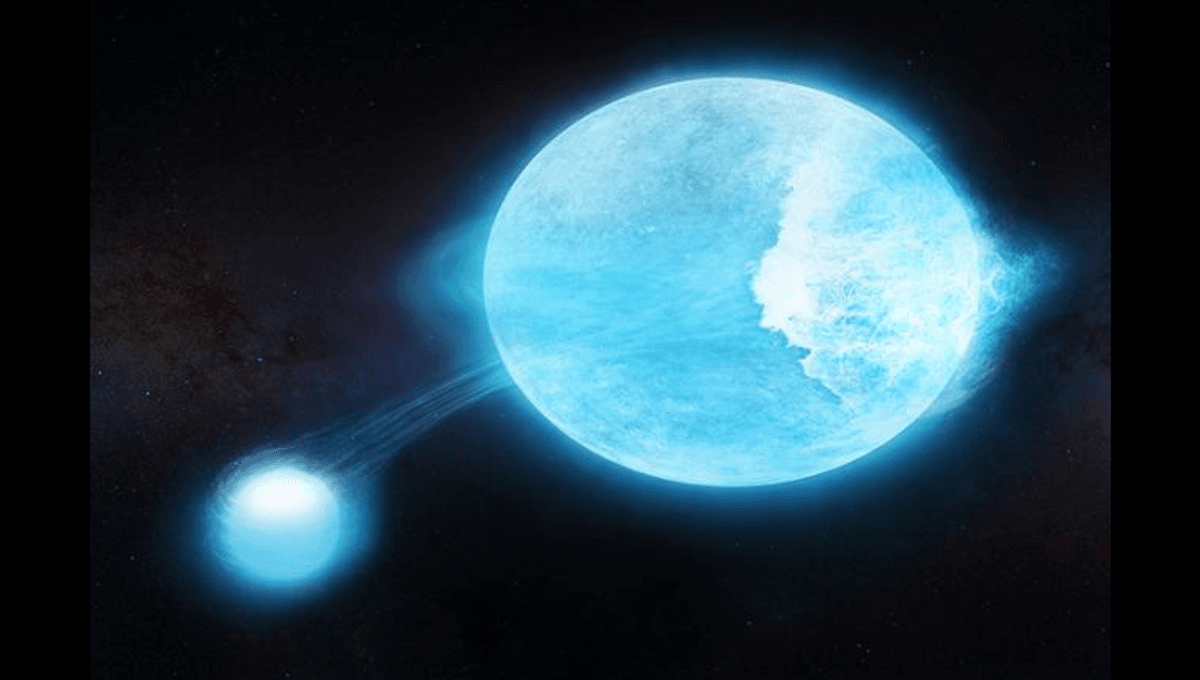
Brightness fluctuations on a star with 10,000 times the Sun’s volume have been explained by enormous waves rippling in its outer layers. Instead of sloshing endlessly around the star, these waves break once a month, throwing gases into orbit.
Naming a star MACHO 80.7443.1718 makes it sound tough. However, this star is called that because the first signs it was unusual were identified by the MACHO Project in the 1990s, an effort to find Massive Compact Halo Objects, once postulated as the explanation for dark matter.
Those early observations revealed that MACHO 80.7443.1718, which lies in the nearby galaxy the Large Magellanic Cloud, is undergoing regular, but extreme, swings in brightness. More recent observations by the Transiting Exoplanet Survey Satellite (TESS) have shown MACHO 80.7443.1718 is a “heartbeat star”, a component of a binary system where regular close approaches between two stars produce variations in brightness with a reliable rhythm.
However, typical heartbeat stars undergo barely detectable 0.1 percent shifts in brightness; MACHO 80.7443.1718 swings by 20 percent. “We don’t know of any other heartbeat star that varies this wildly,” said Dr Morgan MacLeod of the Harvard and Smithsonian Center for Astrophysics in a statement. Astronomers named it and other extreme examples “heartbreak stars”, to distinguish them from their tamer counterparts.
MacLeod and a colleague think they have explained not just this star, but heartbreakers in general.
The larger star in the MACHO 80.7443.1718 is an impressive 34.5 times the mass of the Sun and will end its days in a truly spectacular supernova. The smaller is so much fainter we have never even seen it, and know of it only from its effect on the primary star.
Their orbits raise mutual tides, and MacLeod has concluded the tide on the larger star is about 4.4 million kilometers (2.7 million miles) high. That’s about three times the diameter of the Sun, or 12 times the distance to the Moon. It’s also a fifth of the radius of MACHO 80.7443.1718’s larger component. The Bay of Fundy looks puny by comparison.
MacLeod has created a computer model of these tides, which suggests they start out as smooth bulges that, like water waves, eventually become too steep to be stable, causing them to crash like breakers on the beach. This creates what MacLeod calls “a big foamy mess”.
Instead of just scattering sea spray nearby, the MACHO mess leads to gas escaping the star itself to form a stellar atmosphere. The energy released in the breaking waves also causes the surface of the larger star in the pair to increase its rate of rotation. It is now spinning twice as fast as we would expect of a star of this age and size.
These waves are raised whenever the two stars make their closest approach in their elongated orbits, which happens every 32 days. The effect is to cause the larger star to bulge around 50 percent more at its equator than its poles, a magnified version of what we see on fast spinning stars and the Earth itself.
MacLeod compares the process to a “spinning pizza crust flinging off chunks of cheese and sauce,” although we always thought spinning the pizza dough was done before the toppings were added. Such a process is as unsustainable as it sounds, but stars this big have very short lifespans.
As extreme as MACHO 80.7443.1718 is, it exists as part of a spectrum, rather than being entirely unique. Approximately 1,000 heartbeat stars are known, and of these 20 show fluctuations in brightness considerably greater than the rest, even if this one is the most extreme of all.
The study is published in Nature Astronomy.
Source Link: Waves 3 Times The Size Of The Sun Break On Enormous “Heartbreak” Star